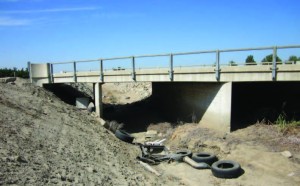
The Tulare County Resource Management Agency (RMA) is taking the bull by its horns and preparing for possible major flooding this winter. With the prediction of an El Nino, the RMA is being proactive in preventing the catastrophic damage that could occur in the event of torrential rains in the Central Valley.
According to the National Oceanic and Atmospheric Administration (NOAA) there is a 50% chance of above average rainfall between October 2015 and May 2016. That could mean one inch of rain over the average rainfall, or 20 inches. If the rain is spread out over the winter months there will possibly be no flooding. But if it comes all at once and with unusual intensity, rivers and water channels will overflow their banks flooding surface streets, highways, homes and businesses.
At the October 27 Tulare County Board of Supervisors (TCBOS) meeting, Reed Schenke, Tulare County Project engineer, outlined the details and goals of the RMA’s Flood Control Action Plan. The goal of the plan is to protect property and lives. The first step to this goal was to list the “hot spots” in the county where flooding was likely to occur. The RMA pin-pointed the hot spots and then met with irrigation and water districts to coordinate plans and equipment. These districts are already prepared to deal with flooding and are willing to collaborate with the county in the needed areas. They are also the organizations that are ready at 2am if and when issues arise.

The next step is to clear the dry waterways where debris and trash have collected undisturbed since the drought began. In some locations homeless encampments have been established under bridges, encampments which would block the flow of water in an intense rain storm. In these cases eviction notices need to be issued and their belongings stored.
Before the county can go in and clean these waterways they need written approval from the property owner, or permission from US Fish and Wildlife if the waterway is a streambed. In anticipation of the necessary permit, RMA has already written up a five-year agreement with Fish and Wildlife to clear streambeds of debris. Fish and Wildlife uses the permit process to prevent disturbing wildlife or the altering or destruction waterways.
In addition to clearing the water channels, sinking and storm basins need to be cleared of vegetation, and after sitting idle for years, flood pumps need to be brought back on line.
The City of Visalia is also starting its preparations for possible flooding by clearing storm drains and making sand bags available to residents. Visalia’s Public Works Department has a self-serve sandbag station located on Cain Street between Goshen and Main Street, just north of the City Corporation Yard. The station is open 24 hours a day, seven days a week. There is a 15 bag limit per person and residents need to bring their own shovel.
Tulare County has sandbags available to the public for self-fill in the event of flooding at the following fire stations: Cutler, Lemon Cove, Three Rivers, Lindsay, Pixley and Doyle Colony Fire Station.
After the presentation, Supervisor Steve Worthley remarked that Tulare County had never been proactive in preparing for flooding but had only acted after the fact. The change in tactics results from the fact that we now have the technology to predict El Ninos and the likelihood of floods.
It has not been that long since the El Nino effect was even discovered, and Schenke pointed out that El Ninos cause more precipitation in Southern California. The rain may not even get this far north. Supervisor Worthley said that in the event that no flood comes this year, at least the county will be prepared for when it does come. He quoted Supervisor Allen Ishida as saying, “every drought ends in flood.”
